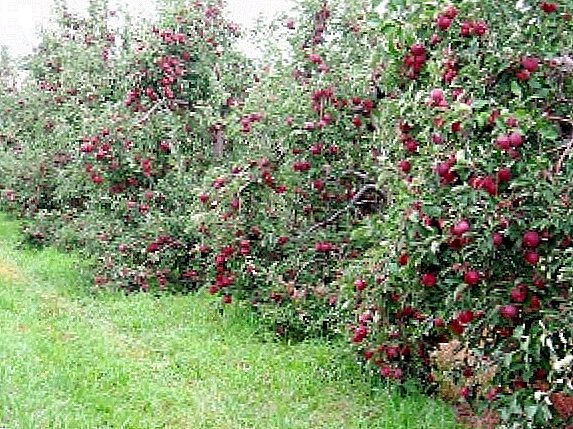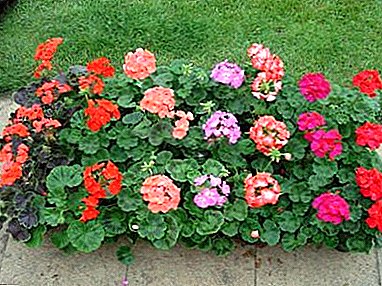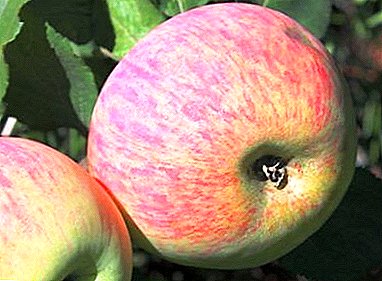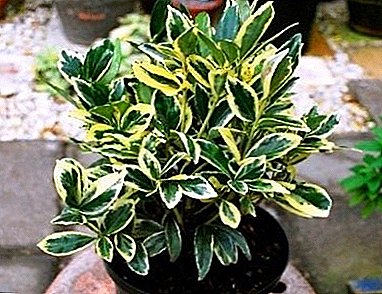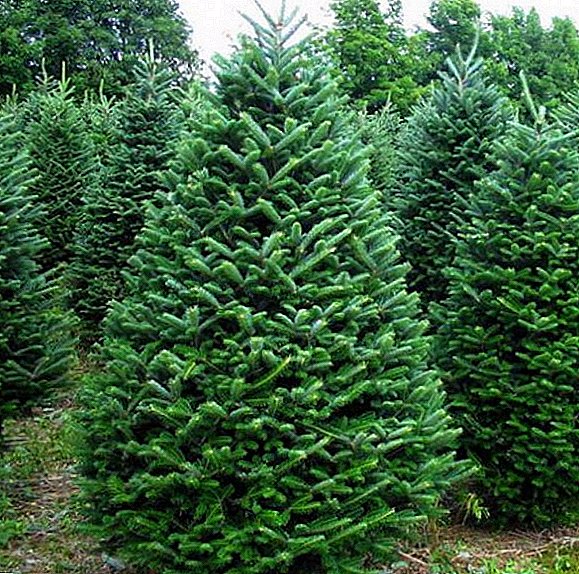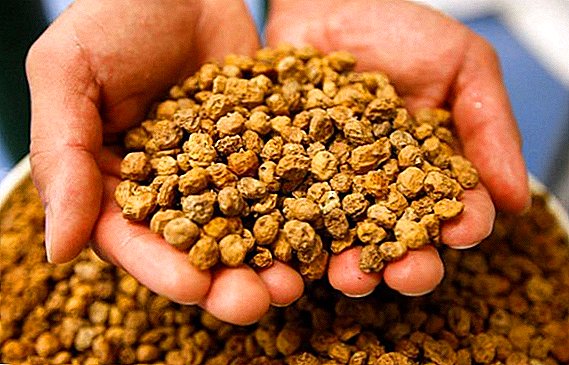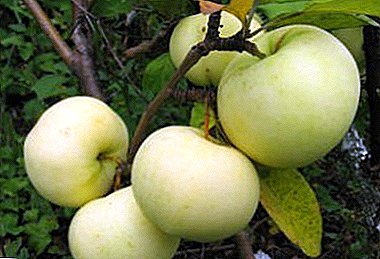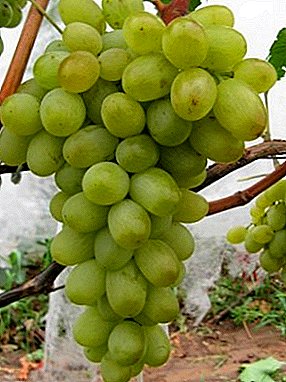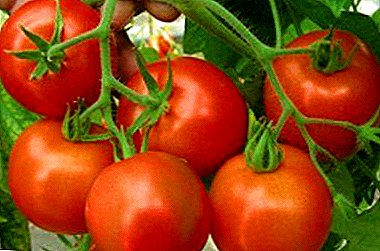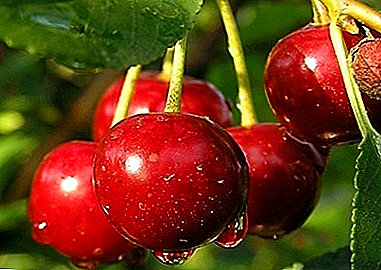
It is difficult to find a person who would not be familiar with a garden plant with the name “cherry”. In terms of its prevalence, cherry is second only to apple.
Every gardener will find a place for her on his plot, and thanks to the constant breeding work on the breeding of new varieties, she will be able to select the type he needs.
Among all this variety there are varieties, beloved by many gardeners and received deserved popularity. These varieties include all the famous cherry Turgenevka (or, as it is also called, Turgenevskaya).
Description of the Turgenevskaya cherry variety, photos and many other useful information - hereinafter referred to.
Breeding history and breeding region
 Cherry Turgenevka bred in the All-Russian Research Institute for Breeding Fruit Crops. "Parents" are A. F. Kolesnikova, T. S. Zvyagina and G. B. Zhdanova and he received a selection of seedlings from the variety Zhukovskaya.
Cherry Turgenevka bred in the All-Russian Research Institute for Breeding Fruit Crops. "Parents" are A. F. Kolesnikova, T. S. Zvyagina and G. B. Zhdanova and he received a selection of seedlings from the variety Zhukovskaya.
In 1979, the cherry variety Turgenevka was entered into the State Register, but the people sometimes call it Turgenevskaya. Description of the variety, as well as photos - in the next section.
Appearance of cherry Turgenevka
Consider separately the appearance of the tree and fruit.
Tree
Cherry varieties Turgenevka - tree up to 3 meters high, crown shape is reverse pyramidal, trunk and main branches are gray-brown, brownish shoots, the branches they form are of medium thickness.
Conical buds are markedly deviated from the shoot; bud size is about 0.5 cm. The leaf is rich green, shiny, pointed on both sides, and has the shape of a boat.
The cherry tree enters the fruiting stage in the fourth or fifth year of fruiting and lives up to twenty-five years.
Fruit
Cherry has weight about 5 grams, wide heart shape and assembled in brush four fruits each. Bones easily move away from the pulp. The taste of cherry is sweet, with a slight sourness. The following varieties Mayak, Molodezhnaya and Robin also have an excellent taste.
 It is interesting to note that the variety Turgenevka belongs to the type Moreli or Griots, as the fruits have intense dark reddish coloring and dark red juice.
It is interesting to note that the variety Turgenevka belongs to the type Moreli or Griots, as the fruits have intense dark reddish coloring and dark red juice.
Good yield, fruit ripening accounts for on the first of july. Variety Turgenevka tolerates winter cold, resistant to fungal diseases.
Podbelskaya, In memory of Vavilov, Novella and Chernokork can also boast high yields.
A photo





Planting and care
- Selection of planting material.
It is very important to choose the planting material. Accidentally purchased tree may disappoint varietal inconsistency. Be careful.
When buying a one-year sapling, be guided by approximately the following parameters: root system 20-30 cm., Stem diameter - 10-12 cm., Height 100-120 cm ...Pay attention to the integrity of the root system, trunk and branches.
Cherry Turgenevka is a self-fruitful variety, it means that not every pollinator can cope with its task, so what kind of pollinator does it need?
Better to plant with varieties Youth and Lyubskaya, varieties will complement each other during pollination, which will significantly increase the yield.
.
- Landing
 For cherries, you need to take a sunny place, protected from cold winds, lowlands do not fit with increased soil moisture. Spring for planting cherries better.
For cherries, you need to take a sunny place, protected from cold winds, lowlands do not fit with increased soil moisture. Spring for planting cherries better.It is necessary to take into account one important fact: the older the plant, the lower the survival rate. For planting are good annual or biennial plants. Well-proven scheme 3 by 3 meters. Landing pit should be 85 cm in size and 45 cm deep.
In each landing hole we fall asleep a humus bucket, 200 gr. superphosphate, 50 gr. potash fertilizer, 400 gr. wood ash, and if the soil is acidified - 200 gr. crushed limestone, thoroughly mixed and planted a cherry, without recessing the root neck.
From the ground we form a side that will not allow water to flow out during watering. Plentifully water the seedling and mulch the soil with humus or peat. It is necessary to install a peg and tie a sapling to it, but not too close, it should not interfere with the growth of a young plant.
- Care.
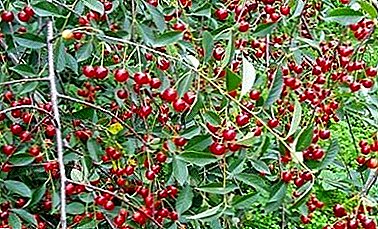 Saplings need constant attention - the soil should not dry out and watering should be carried out as needed, but it is impossible to flood the plant, waterlogging is just as harmful as drying.
Saplings need constant attention - the soil should not dry out and watering should be carried out as needed, but it is impossible to flood the plant, waterlogging is just as harmful as drying.The root system of a young tree grows much faster than the branches, and the stem should be twice as wide as the crown.
The soil of the circle is necessary loosen and mulch not allowing weeds to sprout and crusting with cracks. In autumn, tree trunks are dug up without damaging the roots, which are very close to the surface.
Between seedlings you can sow alfalfa, beans, peas - leguminous plants enrich the soil with nitrogen. Strawberries are also suitable for this, but you do not need to plant tall crops, they shade young plants.Pristvolnye circles do not need to sow. In the event that in the first year after planting the increase in the branches will be less than 60 cmin the autumn must be made half a bucket of humus and 100 grams of double superphosphate.
The following fertilization is necessary with the beginning of fruiting. In the spring one square meter will need 20 grams. ammonium nitrate, 10 gr. double superphosphate, 5 gr. potassium salts. Humus is applied every three years.
When the cherries grow, it is necessary to sodder the soil.
- Crop.
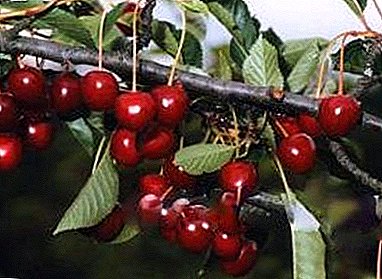 The sapling took root, grew noticeably over the summer, endured the winter well, and with the onset of spring it is necessary to tackle its first pruning. Crop need to prune in early spring, all inflicted wounds must be smeared with garden pitch.
The sapling took root, grew noticeably over the summer, endured the winter well, and with the onset of spring it is necessary to tackle its first pruning. Crop need to prune in early spring, all inflicted wounds must be smeared with garden pitch.Before fruiting pruning wears crown-forming character, and with the onset of fruiting - sanitary. Root sprouts regularly appear under the cherry trees; they need to be cleaned in time.
Pest and disease control
With the onset of spring, an army of a wide variety of pests attacks the cherry trees: cherry moth, damaging the buds, larvae of the cherry slimy sawfly - leaves, cherry aphid - young leaves and shoots, ringed silkworm caterpillars - young buds and leaves, cherry weevil - flowers and fruits. When pests are found, cherry trees are sprayed with insecticides according to the instructions.
 Most often, the cherry is affected by the following diseases: comedations - branches dry, coccomycosis or rust - affects young shoots and leaves, perforated spotting - flowers and leaves die off, fruit rot and gray rot - infect berries.
Most often, the cherry is affected by the following diseases: comedations - branches dry, coccomycosis or rust - affects young shoots and leaves, perforated spotting - flowers and leaves die off, fruit rot and gray rot - infect berries.
Every year, cherry trees are treated with Bordeaux liquid, and once every three years with 3% Nitrofen solution.
The Minx, Ashinskaya, Fairy, Kharitonovskaya demonstrate good resistance to coccomycosis and other fungi.
Widespread among gardeners received a comprehensive processing of cherries from pests and diseases. The first treatment is carried out in the spring with the blooming of the kidneys, as they say, along the green cone.
Insecticide and fungicide are mixed in one working solution. The second treatment is carried out with the same composition after flowering.
This method of protection is therapeutic and preventive in nature and it is impossible to miss a diseased plant or not to notice a pest - they simply do not exist.
Ripening cherries in your garden are waiting for not only you, but also birds. Gardeners have experienced many different ways of protecting ripe cherries, but the most reliable is the net stretched over the trees.
With proper tension, it reliably shelters from uninvited guests.
 Due to the remarkable taste of fruits, high yield and frost resistance, the cherry variety Turgenevka settled in the gardens of the south of Russia, the Black Soil Region and the Non-Black Earth Region of our country.
Due to the remarkable taste of fruits, high yield and frost resistance, the cherry variety Turgenevka settled in the gardens of the south of Russia, the Black Soil Region and the Non-Black Earth Region of our country.
Among the unpretentious and suitable for growing on private farmsteads varieties should pay attention to the varieties Chernokorka, Black Large, Chocolate, Shubinka.
Here you can see reviews of experienced amateur gardener MP Pertsev about cherries of many varieties, including Turgenevka cherries (6 minutes).


 For cherries, you need to take a sunny place, protected from cold winds, lowlands do not fit with increased soil moisture. Spring for planting cherries better.
For cherries, you need to take a sunny place, protected from cold winds, lowlands do not fit with increased soil moisture. Spring for planting cherries better. Saplings need constant attention - the soil should not dry out and watering should be carried out as needed, but it is impossible to flood the plant, waterlogging is just as harmful as drying.
Saplings need constant attention - the soil should not dry out and watering should be carried out as needed, but it is impossible to flood the plant, waterlogging is just as harmful as drying. The sapling took root, grew noticeably over the summer, endured the winter well, and with the onset of spring it is necessary to tackle its first pruning. Crop need to prune in early spring, all inflicted wounds must be smeared with garden pitch.
The sapling took root, grew noticeably over the summer, endured the winter well, and with the onset of spring it is necessary to tackle its first pruning. Crop need to prune in early spring, all inflicted wounds must be smeared with garden pitch.